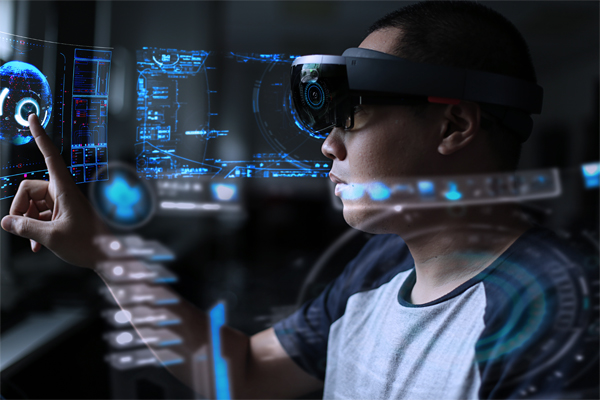UA Online students looking for new and different ways to learn have come to the right place.

Imagine putting on a headset and touching down on another world. A world where you can learn and grow by fully immersing yourself in whatever topic you want.
That dream – to create diverse learning spaces using the latest technologies – inspired the University of Arizona’s Office of Digital Learning, where every UA Online course is built from scratch. That’s why it decided to host both the UA Tech Crawl, held the evening of Thursday, Sept. 28, and OLC Collaborate, a daylong event sponsored by the Online Learning Consortium, on Friday, Sept. 29. What attendees experienced was just a small taste of an exciting future for online education: one that puts students first.
“I always talk about the fact that we need to be where our students are,” said keynote speaker Michael Torrence, assistant vice president of Academic Affairs for Volunteer State Community College in Gallatin, Tennessee. “And if we’re not where our students are, we’re doing them a disservice.”
Torrence’s presentation, titled “The 4th Dimension in Higher Education: Mixed Reality of VR, AR and Holograms,” outlined precisely where those students are and how to reach them.
“It’s transformational what happens when you put these devices into the hands of a young person,” he said. “When you get immersed in the environment … you become more connected to the contextual. That’s the beauty of VR.”
Building New Realities
Torrence suggested we’ve moved beyond the term “digital natives,” which refers to individuals born and raised during the age of digital technology and the internet. Instead, he called modern students “digitally immersed natives” and said educators can meet their needs by bringing virtual and augmented reality technologies into the classroom whenever possible.
The previous day’s tech crawl highlighted the UA’s dedication to integrating new technologies into its online courses by hosting 18 high-tech stations all around the main campus in Tucson, Arizona. These stations, set up by the Office of Digital Learning, University Libraries and other UA groups, featured hands-on demonstrations of educational technologies, including 3-D scanners, printers and more.
Perhaps the most popular station was iSpace on the second floor of the Science and Engineering Library, which boasted a full virtual reality room where users could don a headset and enter a fun, interactive digital workspace in the video game “Job Simulator.”
Video games might seem like an odd choice for online education, but, as Norah Dunbar pointed out during her presentation at OLC Collaborate, introducing components from games into learning environments can have significant benefits.
Gamifying the Classroom
Gameful learning refers to the practice of taking inspiration from elements of good games and applying those to learning environments. Several stops on the UA Tech Crawl highlighted the ways educators are starting to implement these ideas, such as:
- Kahoot!, a free, game-based learning platform that lets students engage in fast-paced group quizzes via their smartphones or other mobile devices.
- Cred.ly, which allows educators to align curricular competencies to digital badges and award them to exceptional students, who can then share these credentials on websites, LinkedIn profiles, social media and more.
How effective is gamification? Dunbar, professor and chair of Communication at the University of California Santa Barbara, provided an answer during her presentation, “The Gamification of Learning: Case Studies in Cognitive Bias and Deception Detection.”
“Video games encourage all kinds of good things … persistence, problem-solving, cooperation, critical thinking,” Dunbar said. “So you can build in training that encourages people to try to learn new things, and they can’t just move on – they can’t pass until they have learned those things.”
Dunbar ran a game lab for her tech crawl station, where two educational games she developed were available to play. The first, “MACBETH,” was designed to train intelligence community analysts in avoiding cognitive biases. The second, “VERITAS,” instructs law enforcement officers in proven methods for detecting deception. She noted that gaming has applications within higher education, too.
“People today play games,” she said. “The average 21-year-old has spent 10,000 hours playing video games … Malcolm Gladwell, in his book [‘Outliers: The Story of Success’], says that 10,000 hours is the number of hours you need to be a virtuoso in something. If we can channel that energy toward a good purpose, something that will help [students] in life, I say let’s go for it.”
Digital Tools, Real Applications
Many of the tools showcased at both events – such as Cred.ly, Kahoot!, Playposit, VoiceThread, Adobe Creative Cloud and more – are already in the hands of UA Online students.
VoiceThread in particular has been shaping the online learning space at the UA, according to Melody Buckner, director of the Office of Digital Learning. It’s a collaboration platform that allows UA Online professors and students to create, share and discuss digital course materials using audio and video, helping to humanize the online environment.
“It is much better than plain text,” Buckner said during the UA Tech Crawl. “You can see the emotion. I’ve had students tell me this is the first time they’ve gotten to know people in an online class.”
Even so, there’s still work to be done making these tools practical for everyday use. As Torrence noted at the end of his presentation, these digital spaces are the future of online education.
“Creating what the UA already has … a more adaptive and flexible platform, a more adaptive and flexible schedule, so that students can learn wherever they want to learn – that’s where we are, and that’s where we’re going.”
For more information about the events and participants, view the UA Tech Crawl event page or the OLC Collaborate and UA Tech Crawl press release.

